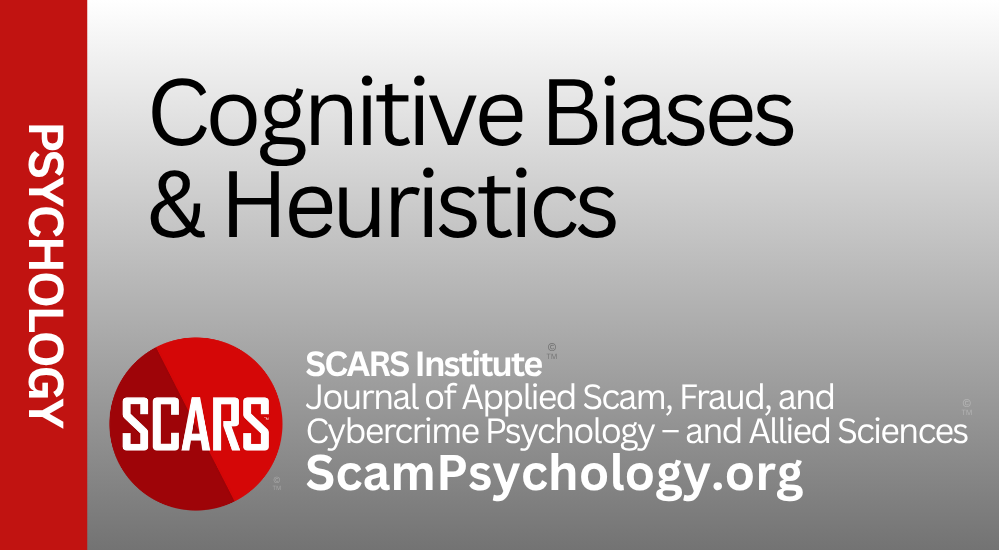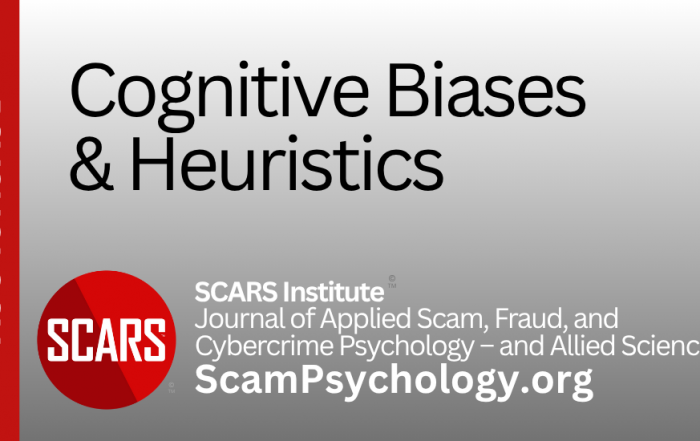Expectancy Violation Theory and the Psychology of Scams
Principal Category: Persuasion Manipulation and Control
Authors:
• Vianey Gonzalez B.Sc(Psych) – Licensed Psychologist, Specialty in Crime Victim Trauma Therapy, Neuropsychologist, Certified Deception Professional, Psychology Advisory Panel & Director of the Society of Citizens Against Relationship Scams Inc.
• Tim McGuinness, Ph.D. – Anthropologist, Scientist, Polymath, Director of the Society of Citizens Against Relationship Scams Inc.
Abstract
The Expectancy Violation Theory, proposed by Judee Burgoon in 1978, offers a framework for understanding how people perceive and react to unexpected or violated expectations during social interactions. This theory posits that when someone’s expectations about a situation or interaction are not met, it can lead to various cognitive, affective, and behavioral responses. Expectations are formed based on past experiences, cultural norms, and social rules, and violations can be positive or negative, exceeding or falling short of these expectations. Violations trigger cognitive processes as individuals attempt to understand the unexpected behavior, elicit emotional reactions, and may prompt behavioral adjustments. The theory acknowledges that the impact of violations can vary based on context and cultural background. In the context of relationship scams, this theory helps explain the psychological dynamics at play for both scammers and victims, from the initial stages of building trust to the eventual revelation of deception. Understanding these dynamics can inform prevention strategies, support services, and legal interventions, ultimately aiding in the reduction of relationship scams.

Expectancy Violation Theory and the Psychology of Scams
What is Expectancy Violation Theory
The Expectancy Violation Theory, proposed by Judee Burgoon in 1978, is a communication theory that explains how people perceive and react to unexpected or violated expectations during social interactions. It posits that when someone’s expectations about a situation or interaction are not met, it can lead to various cognitive, affective, and behavioral responses.
Key components of the theory include:
- Expectations: These are the beliefs or predictions individuals have about how a situation or interaction will unfold. Expectations are formed based on past experiences, cultural norms, and social rules.
- Violations: When the actual behavior or outcome of an interaction deviates from these expectations, a violation occurs. Violations can be positive (exceeding expectations) or negative (falling short of expectations).
- Cognitive Responses: Violations trigger cognitive processes as individuals attempt to understand and interpret the unexpected behavior. This can lead to increased attention and cognitive processing.
- Affective Responses: Violations can elicit emotional reactions, such as surprise, pleasure, or displeasure, depending on the nature of the violation.
- Behavioral Responses: Individuals may alter their behavior in response to violations, either by adapting to the new situation or by attempting to restore the violated expectations.
- Context and Culture: The theory acknowledges that the impact of violations can vary based on the context and cultural background of the individuals involved.
The Expectancy Violation Theory is particularly relevant in understanding interpersonal communication, nonverbal communication, and the dynamics of social interactions. It helps explain why certain behaviors might be perceived as inappropriate or surprising in specific contexts and how individuals adjust their interactions based on these violations.
Expanding on This
Expectations
Expectations are the beliefs or predictions individuals have about how a situation or interaction will unfold. These expectations are not formed in a vacuum but are influenced by a multitude of factors, including past experiences, cultural norms, and social rules. For instance, in a romantic relationship, one might expect their partner to be faithful, communicative, and supportive based on societal norms and personal past experiences. These expectations serve as a mental script that guides our behavior and interpretations during social interactions.
Violations
When the actual behavior or outcome of an interaction deviates from these expectations, a violation occurs. Violations can be categorized as positive or negative. Positive violations occur when the outcome exceeds expectations, such as receiving an unexpected gift or compliment. Negative violations, on the other hand, fall short of expectations, like a partner being unresponsive or dishonest. These violations can range from minor to severe, depending on the context and the extent of the deviation from expected norms.
Cognitive Responses
Violations trigger cognitive processes as individuals attempt to understand and interpret the unexpected behavior. This cognitive engagement can lead to increased attention and processing of the situation. For example, if a friend suddenly starts acting distant, one might spend more time analyzing their behavior, trying to figure out the reason behind the change. This heightened cognitive activity can also involve seeking additional information or clarifying the situation to make sense of the violation.
Affective Responses
Violations can elicit a range of emotional reactions, or affective responses, such as surprise, pleasure, or displeasure. The nature of these emotions depends on whether the violation is perceived as positive or negative. Positive violations might evoke feelings of joy, gratitude, or excitement, while negative violations can lead to frustration, anger, or sadness. These emotional responses are often immediate and can significantly influence how an individual perceives and reacts to the situation.
Behavioral Responses
Individuals may alter their behavior in response to violations, either by adapting to the new situation or by attempting to restore the violated expectations. Behavioral responses can include direct actions, such as confronting the person who violated the expectation, or more subtle adjustments, like changing one’s own behavior to accommodate the new reality. For instance, if a colleague consistently arrives late to meetings, one might start adjusting their own schedule or confront the colleague about the issue.
Context and Culture
The theory acknowledges that the impact of violations can vary based on the context and cultural background of the individuals involved. What might be considered a violation in one culture or context could be perfectly acceptable in another. For example, direct eye contact is expected in many Western cultures during conversations, but in some Eastern cultures, it might be seen as disrespectful. Understanding these cultural and contextual nuances is crucial for interpreting and responding to expectancy violations appropriately.
Applications and Relevance
The Expectancy Violation Theory is particularly relevant in understanding interpersonal communication, nonverbal communication, and the dynamics of social interactions. It helps explain why certain behaviors might be perceived as inappropriate or surprising in specific contexts and how individuals adjust their interactions based on these violations. This theory has wide-ranging applications in various fields, including psychology, sociology, and communication studies.
Interpersonal Communication
In interpersonal communication, the theory helps explain how people navigate social interactions and maintain relationships. For example, in a romantic relationship, partners might have expectations about the frequency and quality of communication. If one partner suddenly becomes less communicative, it can violate these expectations, leading to cognitive, affective, and behavioral responses from the other partner. Understanding these dynamics can help couples better manage their expectations and communicate more effectively.
Nonverbal Communication
Nonverbal communication, such as body language and facial expressions, also plays a significant role in expectancy violations. For instance, if someone expects a friendly greeting but receives a cold, distant response, it can violate their expectations and trigger a range of reactions. The theory helps in interpreting these nonverbal cues and understanding their impact on social interactions.
Social Interactions
In broader social interactions, the theory can explain why certain behaviors are perceived as inappropriate or surprising. For example, in a professional setting, if a colleague unexpectedly displays overly familiar behavior, it can violate professional norms and expectations, leading to discomfort or confusion. Understanding these violations can help individuals navigate social situations more effectively and adapt their behavior accordingly.
Expectancy Violation Theory in Relationship Scams
The Expectancy Violation Theory can be applied to various stages of a relationship scam, offering insights into the psychological dynamics at play for both the scammer and the victim. Here’s how it could apply:
Before the Scam
Victim’s Perspective:
- Expectations: The victim may have expectations based on previous positive experiences with romantic partners or societal norms about how relationships should develop. These expectations often include trust, honesty, and mutual respect.
- Violations: If the scammer’s behavior initially aligns with these expectations (e.g., being attentive, affectionate), the victim may not perceive any violations. However, if there are early signs of deception (e.g., inconsistent stories, reluctance to meet in person), these could be seen as minor violations that the victim might overlook or rationalize. The victim might think, “Maybe they’re just busy” or “Maybe they’re shy about video calls.”
Scammer’s Perspective:
- Expectations: The scammer may expect the victim to be trusting and vulnerable, based on past successful scams or general knowledge of human psychology. They might expect the victim to be flattered by their attention and eager to please.
- Violations: If the victim shows unexpected skepticism or resistance, the scammer might need to adjust their tactics, potentially leading to further violations of the victim’s expectations. For example, if the victim asks for more personal information, the scammer might provide fabricated details, which can create further cognitive dissonance for the victim.
During the Scam
Victim’s Perspective:
- Expectations: As the relationship progresses, the victim may expect increasing levels of intimacy, trust, and commitment. They might anticipate shared experiences, deeper emotional connections, and plans for a future together.
- Violations: The scammer’s actions, such as avoiding video calls, making excuses for not meeting, or requesting money, can violate these expectations. These violations can trigger cognitive dissonance, where the victim struggles to reconcile their positive feelings with the scammer’s deceptive behavior. The victim might think, “Why won’t they meet me? Do they not care about me?”
- Affective Responses: The victim might experience a range of emotions, including confusion, frustration, and eventually, betrayal. These emotional responses can be intense and overwhelming, especially if the victim has invested a significant amount of time and emotion into the relationship.
- Behavioral Responses: The victim may try to seek clarification, confront the scammer, or even comply with their requests in an attempt to maintain the relationship. They might send more messages, try to be more understanding, or even send money to “help” the scammer, hoping to resolve the violations and restore their expectations.
Scammer’s Perspective:
- Expectations: The scammer may expect the victim to become emotionally invested and compliant over time. They might anticipate that the victim will be willing to overlook minor inconsistencies and continue to engage despite any red flags.
- Violations: If the victim becomes overly demanding or starts to question the scammer’s stories, it can violate the scammer’s expectations, leading them to adjust their tactics or even end the scam prematurely. The scammer might feel the need to create new stories or excuses to keep the victim engaged, which can be mentally taxing and increase the risk of being exposed.
After the Scam
Victim’s Perspective:
- Expectations: Post-scam, the victim may expect closure, an explanation, or even justice. They might hope to understand why they were targeted and how they could have prevented it.
- Violations: The realization of being scammed can be a severe violation of trust and self-worth. The victim might feel betrayed not only by the scammer but also by their own judgment. They might think, “How could I have been so stupid?” or “Why didn’t I see the signs?”
- Affective Responses: Emotions can range from anger and sadness to shame and humiliation. The victim might experience a sense of loss, not just of the relationship but also of their sense of self and trust in others.
- Behavioral Responses: The victim may seek support from friends and family, report the scam to authorities, or take steps to protect themselves from future scams. They might become more guarded in their interactions or seek professional help to process their emotions.
Scammer’s Perspective:
- Expectations: The scammer may expect to move on to the next target without much consequence. They might anticipate that the victim will be too embarrassed to report the scam or that authorities will not take action.
- Violations: If the victim takes legal action or publicly exposes the scam, it can violate the scammer’s expectations of anonymity and impunity. The scammer might need to adapt their tactics or even change their identity to avoid detection.
Applications and Implications
- Prevention and Education: Understanding how expectancies are formed and violated can help in creating educational programs that teach people to be more critical and aware of potential red flags in online relationships. By recognizing the signs of expectancy violations, individuals can be better equipped to identify and avoid scams.
- Support for Victims: Knowing the psychological impact of expectancy violations can inform support services for scam victims, helping them process their emotions and rebuild trust. Counselors and therapists can use this understanding to provide more effective support and guidance for victims as they recover from the emotional and financial impact of the scam.
- Scammer Tactics: Scammers can use their understanding of this theory to manipulate victims more effectively, by initially meeting and then carefully violating expectations to keep the victim off-balance. For example, a scammer might start by being overly attentive and affectionate, creating a strong emotional connection, and then gradually introduce violations, such as requests for money, to test the victim’s willingness to comply.
- Legal and Investigative Strategies: Law enforcement can use insights from this theory to better understand the dynamics of scams and develop more effective investigative and prosecutorial strategies. By recognizing the patterns of expectancy violations, investigators can identify potential scammers and gather evidence more efficiently.
- Technological Interventions: Technology companies can use this theory to develop tools and algorithms that help detect and prevent relationship scams. For example, social media platforms could implement features that flag unusual behavior patterns or inconsistencies in user profiles, alerting potential victims to possible violations of their expectations.
Being Aware and Countering It
To be aware of and counter the potential misuse of Expectancy Violation Theory, an individual can adopt several strategies:
- Maintain Realistic Expectations: Be cautious about forming overly idealized expectations, especially in new relationships or interactions. Recognize that perfect alignment with expectations is rare and that some level of deviation is normal.
- Stay Alert for Inconsistencies: Pay close attention to any inconsistencies in the behavior or stories of the person you are interacting with. Inconsistencies can be a sign of expectancy violations and potential deception.
- Ask Direct Questions: If something feels off, don’t hesitate to ask direct questions to clarify any uncertainties. Scammers often rely on ambiguity, and direct questioning can expose their inconsistencies.
- Trust but Verify: While it’s important to trust, it’s also crucial to verify information. This can involve checking facts, cross-referencing stories, or even conducting a background check if necessary.
- Observe Nonverbal Cues: Nonverbal communication can provide valuable insights. Pay attention to body language, facial expressions, and other nonverbal signals that might indicate discomfort or deception.
- Seek Second Opinions: Discuss your interactions with trusted friends or family members. Sometimes, an outside perspective can help identify red flags that you might have missed.
- Set Boundaries: Establish and maintain clear boundaries, especially regarding personal information and financial matters. Be wary of anyone who tries to rush you into sharing sensitive information or making significant commitments.
- Educate Yourself: Learn about common tactics used in scams and manipulation. Knowledge of these tactics can help you recognize when someone is trying to exploit your expectations. This website is a great place to start.
- Stay Calm and Rational: If you suspect that your expectations are being violated, try to stay calm and rational. Emotional responses can cloud judgment and make it harder to assess the situation objectively.
- Document Everything: Keep a record of your interactions, including messages, emails, and any other forms of communication. This can be useful if you need to review the details later or report the incident.
- Trust Your Suspicious Nature: If something feels wrong, trust your suspicions. Often, our gut feelings can alert us to potential issues before our conscious mind fully processes them.
- Take Your Time: Don’t rush into decisions or commitments, especially in new relationships. Allow yourself time to observe patterns and ensure that your expectations are being met consistently.
By employing these strategies, individuals can become more aware of potential expectancy violations and better equipped to counter them, protecting themselves from manipulation and deception.
Conclusion
The Expectancy Violation Theory provides a valuable framework for understanding the complex dynamics of relationship scams and the psychological impact on both scammers and victims. By recognizing how expectations are formed, violated, and responded to, we can gain insights into the tactics used by scammers and the emotional journeys of their victims. This understanding can inform prevention strategies, support services, and legal interventions, ultimately helping to reduce the prevalence and impact of relationship scams. As our interactions become increasingly digital, the relevance of this theory in navigating the complexities of online relationships and protecting individuals from deception will only continue to grow.

Glossary
- Acceptance window — This term describes the range of behaviors a person considers acceptable in an interaction. Scammers test this window with small, odd requests to see what slips through. Narrowing the window with clear boundaries helps reduce risk.
- Adaptation level — This term refers to the personal baseline used to judge whether someone’s behavior feels normal. Scammers shift that baseline with repeated contact and flattery until larger asks feel ordinary. Restoring a healthy baseline begins with time away and neutral feedback from trusted people.
- Affective response — This term describes the immediate emotions that follow a surprise, such as delight, confusion, or fear. Scammers try to trigger strong feelings to speed decisions. Naming the feeling out loud helps slow the moment and protects judgment.
- Attribution analysis — This term describes how a person explains someone else’s behavior. In scams, victims may blame themselves when the better explanation is deception. Using evidence, not emotion, leads to more accurate attributions.
- Baseline behavior — This term refers to the usual pattern of timing, tone, and content in an interaction. Sudden changes in that pattern often signal risk. Comparing messages to the known baseline helps detect manipulation.
- Boundary test — This term describes a small trial designed to see whether a rule will hold. Scammers test boundaries with minor favors, secrecy, or schedule pressure. Stating rules in advance and repeating them calmly keeps control.
- Communicator credibility — This term refers to how believable a person seems based on cues like consistency, clarity, and verifiable details. Scammers borrow credibility using uniforms, stolen photos, or fake job titles. Independent confirmation protects against staged signals.
- Communicator reward value — This term describes the perceived benefits of staying close to a person, such as love, money, or status. High reward value can cause people to excuse red flags. Listing costs and benefits on paper restores balance.
- Consistency check — This term refers to a simple review that compares new claims with earlier statements and verifiable facts. Scammers struggle to stay consistent over time. Writing a short timeline makes gaps easier to see.
- Context cues — This term describes the situation factors that shape expectations, such as setting, role, and timing. Scammers choose contexts that mute suspicion, like holidays or emergencies. Stepping back from the set scene helps restore perspective.
- Cultural expectancies — This term refers to social rules that guide politeness, trust, and distance. Scammers exploit hospitality or respect for authority to block questions. Knowing that courtesy does not require risk protects safety.
- Deception leakage — This term describes small, unintended signs of dishonesty, such as vague answers or shifting details. No single sign proves a lie, but repeated leakage signals caution. Asking precise questions exposes weak stories.
- Disconfirmation pattern — This term refers to a sequence where concerns are denied, minimized, or redirected. Scammers use this pattern to keep control. Pausing the conversation after repeated denial protects clarity.
- Disengagement cue — This term describes a sign that someone intends to withdraw or avoid accountability, such as abrupt silence or a sudden trip. Scammers use exits to dodge verification. Treating disengagement as data prevents chasing.
- Disruption tolerance — This term refers to how much uncertainty a person can handle without rushing. Scammers push discomfort until people accept fast solutions. Practicing short pauses increases tolerance and protects choices.
- Expectancy calibration — This term describes the process of updating expectations with new evidence. Scammers resist calibration by blocking verification. Regularly adjusting expectations to facts supports sound judgment.
- Expectancy contract — This term refers to the implicit agreement about how contact will work, including pace, openness, and respect. Scammers rewrite the contract toward secrecy and urgency. Reasserting the original terms keeps the frame stable.
- Expectancy window — This term describes the specific range of outcomes a person anticipates in a relationship stage. Scammers widen that window with storytelling until extreme requests feel possible. Returning to common norms helps reset reality.
- Face-saving move — This term refers to a tactic used to avoid shame when questioned, such as blaming a third party or claiming illness. Scammers rely on face-saving to deflect proof requests. Sticking to the original question prevents derailment.
- Framing shift — This term describes a change in how information is presented to steer decisions. Scammers shift frames from romance to crisis to money. Labeling the frame change out loud reduces its power.
- Heuristic override — This term refers to a moment when fast mental shortcuts are paused so careful thinking can take over. Scammers try to block this override with time pressure. Counting to ninety and writing one question restores control.
- Interaction adaptation — This term describes how people adjust posture, pace, and tone to match a partner. Scammers mirror to build quick trust. Watching for over-matching helps keep perspective.
- Intensity matching — This term refers to the level of emotional energy in a message compared to the situation. Scammers over-intensify to hurry the agreement. Asking for calm, plain details helps right-size the tone.
- Negative violation — This term describes an action that falls below reasonable expectations, such as refusal to video chat. Repeated negative violations show risk. Treating the pattern, not the apology, as the truth supports safety.
- Norm salience — This term refers to how clearly a social rule is top of mind during an interaction. Scammers blur norms around money, privacy, and speed. Posting personal rules in visible places keeps them active.
- Norm violation — This term describes behavior that breaks a clear social or platform rule. One violation can be an error; repeated violations signal intent. Reporting and blocking protect the community and oneself.
- Positive violation — This term describes behavior that exceeds expectations in surprising good ways, such as intense praise early on. Scammers use early over-delivery to hook attention. Slowing the pace keeps gifts and promises in proportion.
- Priming script — This term refers to a prepared storyline that shapes what the other person will expect next. Scammers prime with shared-future talk before requesting funds. Noticing the script prevents being led.
- Reciprocity rule — This term describes the pull to give back after receiving help or kindness. Scammers seed favors to trigger this rule. A simple thank-you without obligation protects boundaries.
- Red-flag escalation — This term refers to the rise in warning signs across time, not just a single event. Tracking changes in a short log makes the climb obvious. Action becomes easier when the pattern is visible.
- Response latency — This term describes the delay between question and answer. Unusual delays, or instant replies that ignore the question, suggest scripts or avoidance. Keeping questions specific reveals true latency.
- Script deviation — This term refers to a departure from a common sequence, like rapid declarations of love before meeting. Scammers rely on unusual pacing to unsettle judgment. Returning to standard order reduces risk.
- Signal amplification — This term describes how standout cues, such as uniforms or charity logos, make messages feel truer than they are. Scammers stack symbols to amplify trust. Independent checks cut through the noise.
- Surprise effect — This term refers to the brief mental freeze that follows an unexpected event. Scammers strike during that window to push decisions. Taking a timed pause turns surprise into information.
- Threshold of concern — This term describes the point at which a person decides to verify, pause, or exit. Scammers try to raise that threshold with flattery or guilt. Setting a low, fixed threshold keeps action simple.
- Tuning in — This term refers to the deliberate switch from autopilot to attentive listening. Scammers exploit distraction to slip in requests. Saying the goal of the call or chat aloud helps hold focus.
- Violation interpretation — This term describes the story a person builds to explain a broken expectation. Scammers supply ready excuses to control that story. Holding multiple explanations until facts arrive reduces error.
- Violation valence — This term refers to whether a broken expectation feels good or bad. Both types can be used to steer behavior. Treating all strong surprises as checkpoints improves safety.
- Vulnerability window — This term describes periods when people are more open to risk, such as grief, illness, or isolation. Scammers target those windows with tailored scripts. Extra verification during these times reduces exposure.
References
- “Expectancy violations theory.” https://en.wikipedia.org/wiki/Expectancy_violations_theory
- Positive Psychology. “Victor Vroom’s Expectancy Theory of Motivation.” https://positivepsychology.com/expectancy-theory/
- Wiley Online Library. “Closer People Hurt You More: How Social Distance Modulates Deception‐Triggered Trust Decline and Trust Repair.” https://onlinelibrary.wiley.com/doi/10.1002/ijop.70095
- VCU Business Foundations. “9.4 Expectancy Theory.” https://pressbooks.library.vcu.edu/businessfoundations201/chapter/9-4/
- Emerald Insight. “The expectancy violation effect: how negative performance feedback affects firms’ M&A intensity.” https://www.emerald.com/insight/content/doi/10.1108/cms-12-2022-0476/full/html
- “Discussion Response 5.” https://www.cliffsnotes.com/study-notes/23960463
- Wiley Online Library. “Which Theory Better Explains Multilinguals’ Translation Classroom Engagement: Situated Expectancy‐Value Theory or Control‐Value Theory?” https://onlinelibrary.wiley.com/doi/10.1111/ijal.12723
- “Applications of Expectancy-Value Theory in Promoting Motivated Behavior in Cognitive Training.” https://link.springer.com/article/10.1007/s41465-025-00332-6

Welcome to the SCARS INSTITUTE Journal of Scam Psychology
A Journal of Applied Scam, Fraud, and Cybercrime Psychology – and Allied Sciences
A dedicated site for psychology, victimology, criminology, applied sociology and anthropology, and allied sciences, published by the SCARS INSTITUTE™ – Society of Citizens Against Relationship Scams Inc.
TABLE OF CONTENTS
A Question of Trust
At the SCARS Institute, we invite you to do your own research on the topics we speak about and publish, Our team investigates the subject being discussed, especially when it comes to understanding the scam victims-survivors experience. You can do Google searches but in many cases, you will have to wade through scientific papers and studies. However, remember that biases and perspectives matter and influence the outcome. Regardless, we encourage you to explore these topics as thoroughly as you can for your own awareness.
Please Leave A Comment
Recent Comments
On Other Articles
on Psychological Trauma & Stress And Its Effects On Sufferer’s Genetics – 2024: “Very interesting article. I have wondered sometimes if the way I respond to trauma was due to the trauma and…” Aug 14, 11:15
on Psychological Denial – A Maladaptive Coping Mechanism In Scam Victims – 2024: “I can see from this article how denial can become a coping mechanism for individuals after a scam. I myself…” Jul 15, 19:51
on Reductive Thinking – A Maladaptive Coping Mechanism – An Enemy Of Scam Victims Recovery – 2024: “Very good article that explained the differences between reductive thinking and minimizing. I’m not sure but it seems that minimizing…” Jul 13, 20:14
on Self-Hate In Scam Victims And Its Impact From Psychological Trauma – 2024: “At one time in my life I felt self hate and I did at one point want to end my…” Jul 6, 15:23
on Victim Complex/Victim Mentality In Relationship Scam Victims 2023: “Thank you for another great article. I have known a few people with victim mentality in my life. Knowing them…” Jul 6, 13:35
A Note About Labeling!
We often use the term ‘scam victim’ in our articles, but this is a convenience to help those searching for information in search engines like Google. It is just a convenience and has no deeper meaning. If you have come through such an experience, YOU are a Survivor! It was not your fault. You are not alone! Axios!
Statement About Victim Blaming
Some of our articles discuss various aspects of victims. This is both about better understanding victims (the science of victimology) and their behaviors and psychology. This helps us to educate victims/survivors about why these crimes happened and to not blame themselves, better develop recovery programs, and to help victims avoid scams in the future. At times this may sound like blaming the victim, but it does not blame scam victims, we are simply explaining the hows and whys of the experience victims have.
These articles, about the Psychology of Scams or Victim Psychology – meaning that all humans have psychological or cognitive characteristics in common that can either be exploited or work against us – help us all to understand the unique challenges victims face before, during, and after scams, fraud, or cybercrimes. These sometimes talk about some of the vulnerabilities the scammers exploit. Victims rarely have control of them or are even aware of them, until something like a scam happens and then they can learn how their mind works and how to overcome these mechanisms.
Articles like these help victims and others understand these processes and how to help prevent them from being exploited again or to help them recover more easily by understanding their post-scam behaviors. Learn more about the Psychology of Scams at www.ScamPsychology.org
Psychology Disclaimer:
All articles about psychology, neurology, and the human brain on this website are for information & education only
The information provided in these articles is intended for educational and self-help purposes only and should not be construed as a substitute for professional therapy or counseling.
While any self-help techniques outlined herein may be beneficial for scam victims seeking to recover from their experience and move towards recovery, it is important to consult with a qualified mental health professional before initiating any course of action. Each individual’s experience and needs are unique, and what works for one person may not be suitable for another.
Additionally, any approach may not be appropriate for individuals with certain pre-existing mental health conditions or trauma histories. It is advisable to seek guidance from a licensed therapist or counselor who can provide personalized support, guidance, and treatment tailored to your specific needs.
If you are experiencing significant distress or emotional difficulties related to a scam or other traumatic event, please consult your doctor or mental health provider for appropriate care and support.
Also, please read our SCARS Institute Statement About Professional Care for Scam Victims – here
If you are in crisis, feeling desperate, or in despair please call 988 or your local crisis hotline.
SCARS Institute Resources:
- If you are a victim of scams go to www.ScamVictimsSupport.org for real knowledge and help
- Enroll in SCARS Scam Survivor’s School now at www.SCARSeducation.org
- To report criminals visit https://reporting.AgainstScams.org – we will NEVER give your data to money recovery companies like some do!
- Sign up for our free support & recovery help by https://support.AgainstScams.org
- Follow us and Find our podcasts, webinars, and helpful videos on YouTube: https://www.youtube.com/@RomancescamsNowcom
- SCARS Institute Songs for Victim-Survivors: https://www.youtube.com/playlist…
- See SCARS Institute Scam Victim Self-Help Books at https://shop.AgainstScams.org
- Learn about the Psychology of Scams at www.ScamPsychology.org
- Dig deeper into the reality of scams, fraud, and cybercrime at www.ScamsNOW.com and www.RomanceScamsNOW.com
- Scam Survivor’s Stories: www.ScamSurvivorStories.org
- For Scam Victim Advocates visit www.ScamVictimsAdvocates.org
- See more scammer photos on www.ScammerPhotos.com













![niprc1.png1_-150×1501-11[1]](https://scampsychology.org/wp-content/uploads/2025/05/niprc1.png1_-150x1501-111.webp)